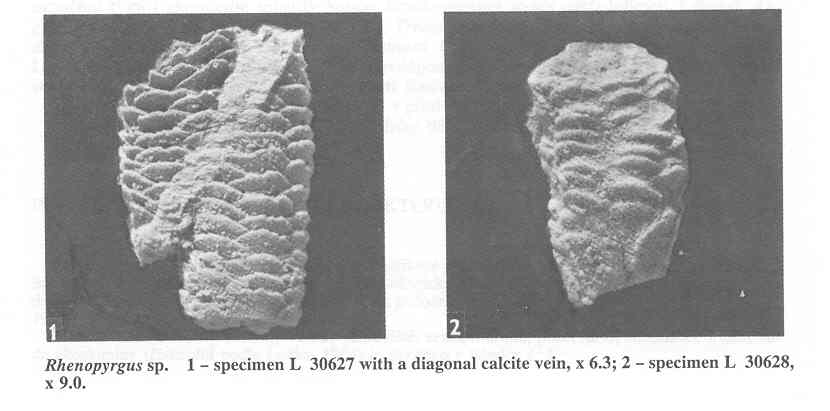
|
First find of edrioasteroids (Echinodermata) in the Bohemian Devonian (Barrandian area) První nález edrioasteroidů (Echinodermata)
v českém devonu (Barrandien)
|
Časopis Národního Muzea, Řada přírodovědná, Vol. 163 (1-4), p. 93-94, Praha 1994.
Until now, no report about the presence of edrioasteroids in the Devonian
of the Czech Republic has appeared. During the current systematic study
of the echinoderms from the so-called "white beds" of the Lower Devonian
of the Barrandian area, however, three undoubted remains of edrioasteroids
have been found, belonging all to the genus Rhenopyrgus DEHM,
1961 and very probably to a new species which is herein provisionally designated
as Rhenopyrgus sp.
Rhenopyrgus DEHM, 1961
Type species: Pyrgocystis coronaeformis J. RIEVERS, 1961; Lower Devonian, Hunsrück Shale, Germany.
For stratigraphic and palaeogeographic distribution of the different species of this genus see especially: DEHM, 1961; HOLLOWAY & JELL, 1983; and LE MENN, 1987. See also RICHTER (1930), J. RIEVERS (1961), REGNÉLL (1966) and KUTSCHER & SIEVERTS-DORECK (1968).
Rhenopyrgus sp.
(Figs 1, 2)
Material: two specimens from the Dvorce-Prokop Limestone (figured herein on Figs. 1, 2) coming from the coll. Růžička, inv. n. L 30627 and L 30628, and one specimen from the Loděnice Limestone (found by R. J. P.), inv. n. L 30629. All material is deposited in the National Museum, Praha.
Description: Only the turret ("Theka-Turm" of DEHM, 1961) is preserved in the material from the Bohemian Lower Devonian. The basal sac (Basal-Säckchen) and the ventral disc (Ambulakral-Krone) are unknown. The turret is composed of distinct, adorally imbricating scale-like plates arranged in 6 vertical columns (invariably in all three specimens). There are in the specimen L 30627 33, in L 30628 10 and in L 30629 at least 8 horizontal rows of imbricating (and laterally alternating) scale-like plates preserved. The turret has a maximum preserved length (in the specimen L 30627) 8.5 mm and the diameter 3 mm, while, in L 30628 which is represented only by lower part of the turret, the length attains 5 mm, with the upper diameter 3 mm and lower diameter 2 mm.
Occurrence: "U kantiny" quarry,
Dvorce-Prokop Limestone (Lower Devonian, Pragian, Praha-Formation) and
"Červený lom" quarry, upper part of the Loděnice Limestone (bathymetrically
shallower facies of the same stratigraphical position).

DEHM, R. (1961): Über Pyrgocystis (Rhenopyrgus nov. subgen.) coronaeformis RIEVERS aus dem rheinischen Unter-Devon. - Mitt. Bayer. Staatsslg. Pal. hist. Geol., 1: 13-17. München.
HOLLOWAY, D. J. - JELL, P. A. (1983): Silurian and Devonian edrioasteroids from Australia. - J. Paleont., 57(5): 1001-1016. Lawrence.
KUTSCHER, F. - SIEVERTS-DORECK, H. (1968): Pyrgocystis-Arten im Hunsrückschiefer und mittelrheinischen Unterdevon. In: Beiträge zur Sedimentation und Fossilführung des Hunsrückschiefers, 21. - Notizbl. hess. L.-Amt Bodenforsch., 96: 7-17. Wiesbaden.
LE MENN, J. (1987): Nouveaux Échinodermes des schistes et calcaires du Dévonien inférieur du Bassin du Laval (Massif armoricain, France). - Geobios, 20(2): 215-235. Lyon.
REGNÉLL, G. (1966): Edrioasteroids. In: R. C. MOORE (Ed.): Treatise on Invertebrate Paleontology, Part U, Echinodermata 3 (Asterozoans, Echinozoans), U136-U173. Geological Society of America and University of Kansas Press, Lawrence.
RICHTER, R. (1930): Schuppenröhren als Anzeiger von zwei im deutschen Devon neuen Echinodermen-Gruppen. (Edrioasteroidea BILLINGS und Ophiocistia SOLLAS?). - Senckenbergiana, 12: 279-304. Frankfurt a. M.
RIEVERS, J. (1961): Eine neue Pyrgocystis (Echinod., Edrioasteroidea) aus den Bundenbacher Dachschiefern (Devon). - Mitt. Bayer. Staatsslg. Pal. hist. Geol., 1: 9-11. München.
Rudolf J. Prokop, paleontologické oddělení, Národní muzeum,
115 79 Praha 1, Czech Republic. - 29. 11. 1993.
Václav Petr, katedra paleontologie, Přírodovědecká fakulta
UK, 128 43 Praha 2, Czech Republic. - 29. 11. 1993.
.
|
|
|
|
|
|
|